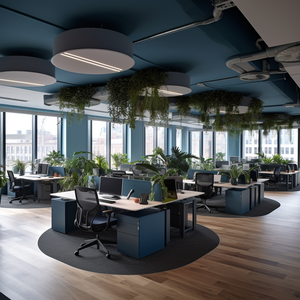In today's rapidly evolving business environment, office space planning can feel like navigating a complex maze. With considerations ranging from employee comfort to efficient workflow design, space utilization can significantly impact productivity, collaboration, and overall business performance. This article provides practical tips to guide businesses through the office space planning maze.
The Importance of Office Space Planning
Office space planning is much more than arranging desks and chairs. It involves creating a workspace that facilitates efficient workflows, fosters collaboration, boosts employee morale, and reflects the company's culture. A well-planned office can improve productivity, retain talent, and make a lasting impression on clients.
Tips for Navigating the Office Space Planning Maze
Analyze Your Needs
Start by understanding your specific needs. Consider your company's work processes, team sizes, required equipment, storage needs, and growth projections. This information will form the foundation of your office layout design.Prioritize Flexibility
The future of work is flexible. Consider incorporating modular furniture and adjustable workspaces that can be easily reconfigured to adapt to evolving needs.Balance Collaboration and Privacy
While open office layouts can foster collaboration, they may also lead to distractions. Balance this by providing quiet zones or private spaces for focused work.Optimize for Comfort
Comfortable employees are often more productive. Ensure your layout includes ergonomic furniture and areas for relaxation. Remember to consider factors like natural light, noise levels, and indoor air quality. Some ergonomic furniture solutions are also space savers. One example is height-adjustable desks. When you set the desk to max height and your chair to it's lowest, it is often possible to put the chair under the desk. Additionally monitor arms and cable management can save desktop space.Leverage Technology
With the rise of digital transformation, much of the physical storage can be eliminated. This can free up considerable space, providing more room for collaboration areas or additional workstations.Plan for Growth
As you plan your office space, consider your business's potential growth. Leaving some room for expansion can prevent future disruptions and costly reconfigurations.Engage a Professional
If office space planning feels overwhelming, consider hiring a professional. Space planning experts can provide valuable insights and solutions tailored to your specific needs and constraints.Conclusion: Mastering the Space Planning Maze
Navigating the office space planning maze is no small feat, but with careful planning and strategic thinking, it is certainly manageable. By focusing on flexibility, employee comfort, and future growth, businesses can create a workspace that not only meets their current needs but also adapts to future changes. By mastering this complex maze, businesses stand to enhance productivity, improve employee satisfaction, and ultimately drive better business performance.

